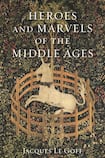
If you are a parent of an eight-year-old girl you are likely to meet unicorns on a daily basis. Multicoloured unicorns with rainbow-hued manes and tails on T-shirts and pyjamas and drawings stuck on the fridge. Your daughter will write stories about unicorns and even have one as pet in some virtual technological world she inhabits with her friends. And when you ask what’s so great about unicorns you’ll be told, “Well, they’re magic!” But you still won’t get it.
To begin to understand, you need to go straight to the unicorn chapter of this first English translation of Heroes and Marvels of the Middle Ages by the French medievalist Jacques le Goff (1924-2014). The existence of the unicorn has been attested since classical times, including in Pliny’s De Rerum Natura, but the key text, Goff tells us, is a Gnostic treatise written in Greek in Alexandria between the second and fourth centuries AD, and soon translated into Latin, called the Physiologus:
“He is a small animal like a kid, is exceedingly shrewd, and has one horn in the middle of his head. The hunter cannot approach him because he is extremely strong. How then do they hunt the beast? Hunters place a chaste virgin before him. He bounds forth into her lap and she warms and nourishes the animal and takes him into the palace of kings.”
The unicorn then pursued a rich literary career through the Middle Ages, always retaining this characteristic: he could only by captured and tamed by a chaste young girl.
For the concerned parent finally getting the low-down dirt on these cute beasts, it gets even more complicated. The unicorn then gets heavily involved with religious symbolism, joins cults and gets mixed up with anti-Semites. Le Goff cites a long poem from 1210 by William the Clerk of Normandy, which concludes:
This extraordinary beast
which has only one horn on its head
represents our Lord
Jesus Christ, Our Saviour . . .
. . . the Jews watch out for him
and ultimately grab him and tie him down;
they take him before Pilate
where they sentence him to death.
The unicorn later escapes the extremists and turns up found in courtly romantic poetry, symbolising the lover enchanted and powerless, and perhaps deceived, by his love.
Antidote to poison
Then again, the unicorn was sometimes conceived of rationally, like any other creature rarely sighted by the average European, like the elephant or the rhinoceros – though the rhino too, we learn, symbolised Christ in the allegorical world of the Middle Ages – and exploited for its utility. Unicorn horn was believed to be a powerful antidote to poison and one of two examples (narwhal tusks, in fact) in the treasury of San Marco, Venice, is inscribed in Greek on how the unicorn protects against toxins.
Le Goff concludes his chapter on this animal with a rather cursory look at his modern career. This would make it seem that unicorns are less common and influential than they used to be – which is clearly not true.
There seems to be no binding idea that would turn this collection of chapters into an integral volume. Rather, it is a collection of wonders and strange facts that add up to an impression of how the medieval imagination persists in our own, and at other times doesn’t. Le Goff is interested in what caught the imagination of the Middle Ages, less interested in speculating on the mechanism by which some images and stories kept their grip and others did not. Or else assumed another form.
And oddly, nowhere in a book that delves into a number of persistent mythological and narrative themes does Le Goff ever use the words archetype or archetypical. Perhaps he disapproved of the concept. There is no way to tell. Yes, a little Jung might have gone a long way.
Summation vs theme
Here we have a look at the symbolic centres of power – the castle, the cathedral, the cloister. We meet knights and troubadours and jesters. Mythical creatures and monsters. Merlin and Robin Hood. Reynard the Fox. Le Goff provides a summation of each subject covered rather than developing an overarching theme, and the effect is rather like flicking through a magazine – the chapters can be read in any order. But the sentences are readable and don’t head into any of the syntactical jungles fetishised in French academia. For this we may be grateful.
So take it as you find it and browse. You may be interested in historical figures that become mythical and literary – El Cid and Charlemagne. Or fascinated by literary creations which, like the fake news of the Middle Ages, catch hold of the imagination and were believed true. Such as the story of Pope Joan. A tale did the rounds in the 1200s that several centuries previously a women disguised as a man had become pope, only to be discovered when she gave birth and died during a religious procession through the streets of Rome.
The fear of the most patriarchal of institutions being infiltrated by stealth seems to have been so potent that in time it became official history. In 1302, Bartholemew of Lucca, a disciple of St Thomas Aquinas, listed Joan as the 107th pope. It even became that old thing called “common knowledge” that in order to avoid any further mistakes the pontifical “parts” were verified manually by a cardinal prior to inauguration and that a special chair existed for this purpose.
So even if the papal cojones were not destined for procreative use, their existence had to be testified to. And you know where the word “testify” comes from, don’t you?
There’s a unicorn on the cover. If you leave it lying around, children will ask questions. Parental guidance advised.










